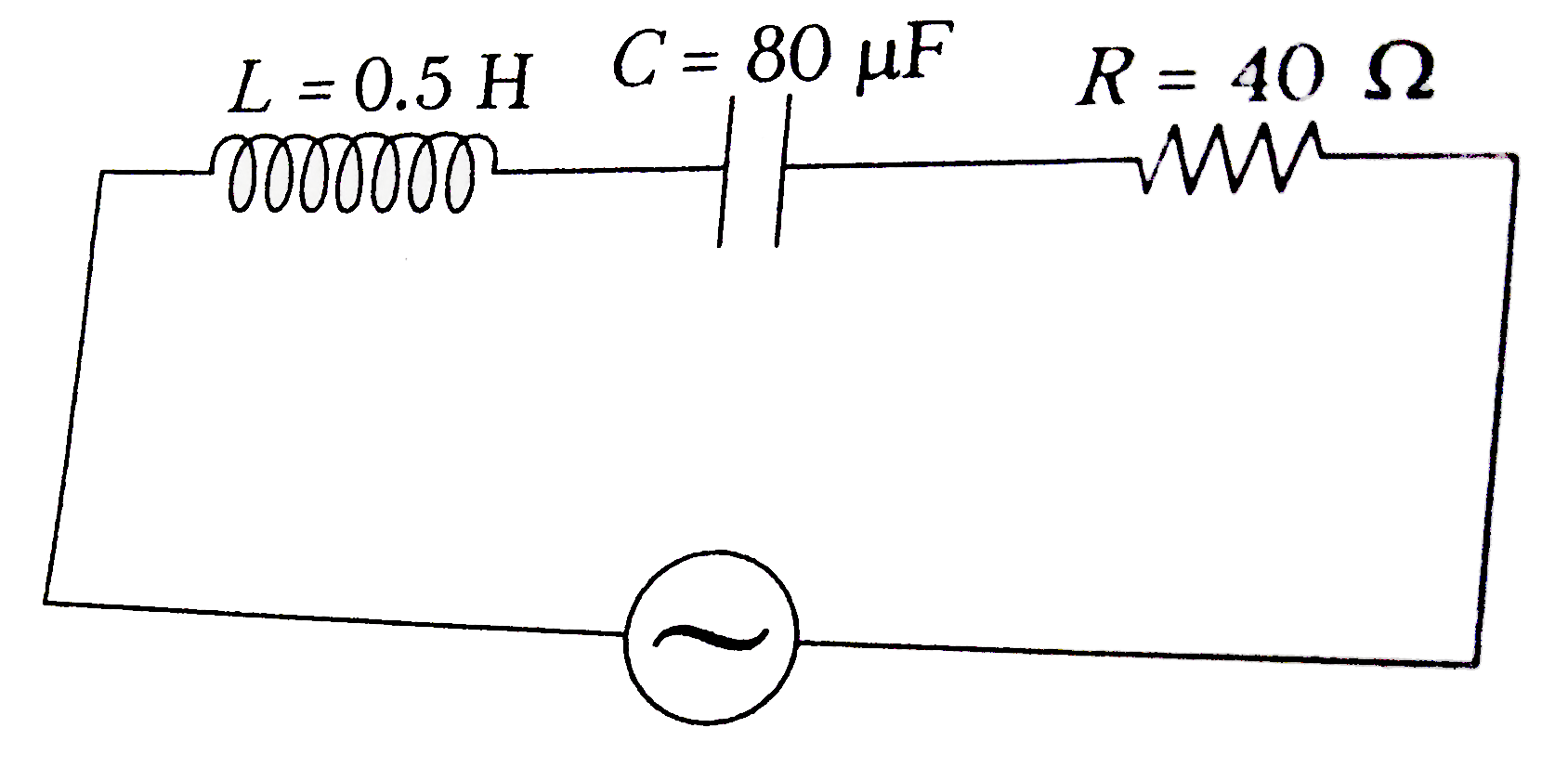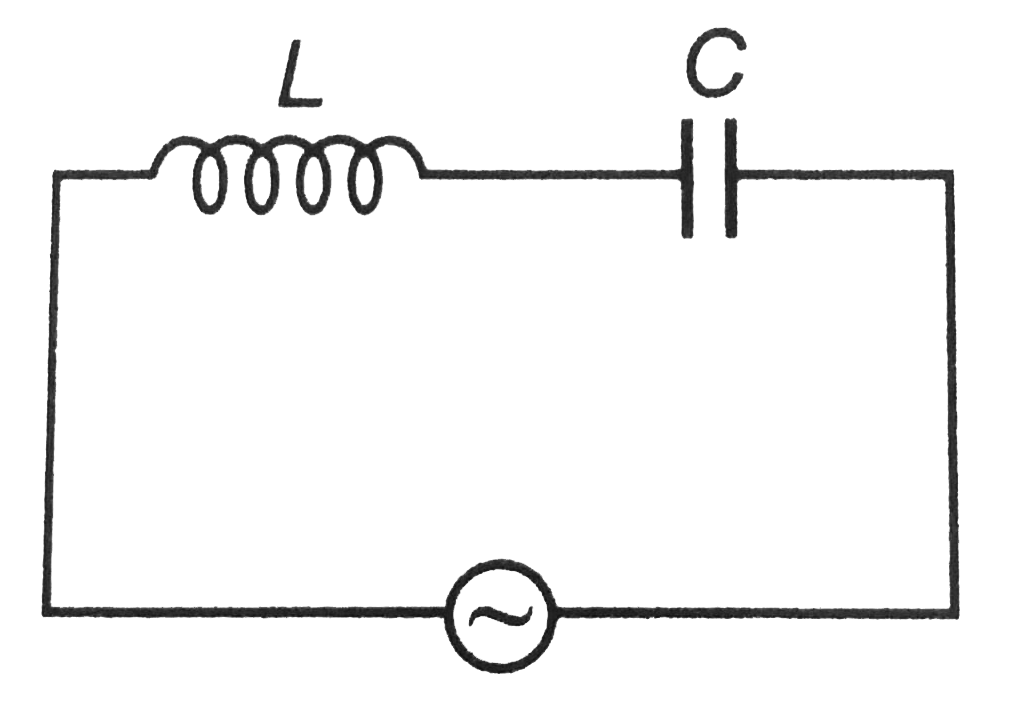A series L-C-R circuit is connected across a variable frequency source of emf. VL,VC,VR are instantaneous voltage drops across inductor capacitor and resistor and V is instantaneous voltage across the circuit.
Column I Column II(A)|V|(p)Can be greater than zero(B)|V|−|VL|(q)Can be less than zero(C)|V|−|VC|(r)Can be equal to zero(D)|V|−|VR|
The correct Answer is:A(p,r), B(p,q,r), C(p, q, r), D(p, r)
To solve the problem, we will analyze the relationships between the instantaneous voltages in a series L-C-R circuit connected to a variable frequency source of emf.
1. Understanding the Circuit:
In a series L-C-R circuit, the voltages across the inductor (V_L), capacitor (V_C), and resistor (V_R) are related to the total voltage (V) across the circuit. The relationships can be expressed in terms of phasors.
2. Voltage Relationships:
- The voltage across the resistor (V_R) is in phase with the current.
- The voltage across the inductor (V_L) leads the current by π2 (90 degrees).
- The voltage across the capacitor (V_C) lags the current by π2 (90 degrees).
3. Phasor Diagram:
When we draw the phasor diagram, we can represent:
- V_R along the horizontal axis.
- V_L vertically upwards (since it leads).
- V_C vertically downwards (since it lags).
4. Total Voltage (V):
The total voltage V can be represented as:
V=VR+(VL−VC)
This means that V can be expressed in terms of the voltages across the inductor and capacitor.
5. Analyzing Each Option:
- (A) |V|: The magnitude of the total voltage can be greater than zero (P is correct).
- (B) |V| - |V_L|: This can be greater than zero, less than zero, or equal to zero depending on the values of V and V_L (P, Q, R are correct).
- (C) |V| - |V_C|: Similar to option B, this can also be greater than zero, less than zero, or equal to zero (P, Q, R are correct).
- (D) |V| - |V_R|: The total voltage can be greater than or equal to V_R, but it cannot be less than zero (P and R are correct).
6. Final Answers:
- For (A): P (can be greater than zero)
- For (B): P, Q, R (can be greater than, less than, or equal to zero)
- For (C): P, Q, R (can be greater than, less than, or equal to zero)
- For (D): P, R (can be greater than or equal to zero)
Summary of Correct Options:
- (A) P
- (B) P, Q, R
- (C) P, Q, R
- (D) P, R
In a series L-C-R circuit, the voltages across the inductor (V_L), capacitor (V_C), and resistor (V_R) are related to the total voltage (V) across the circuit. The relationships can be expressed in terms of phasors.
- The voltage across the resistor (V_R) is in phase with the current.
- The voltage across the inductor (V_L) leads the current by π2 (90 degrees).
- The voltage across the capacitor (V_C) lags the current by π2 (90 degrees).
When we draw the phasor diagram, we can represent:
- V_R along the horizontal axis.
- V_L vertically upwards (since it leads).
- V_C vertically downwards (since it lags).
The total voltage V can be represented as:
V=VR+(VL−VC)
This means that V can be expressed in terms of the voltages across the inductor and capacitor.
- (A) |V|: The magnitude of the total voltage can be greater than zero (P is correct).
- (B) |V| - |V_L|: This can be greater than zero, less than zero, or equal to zero depending on the values of V and V_L (P, Q, R are correct).
- (C) |V| - |V_C|: Similar to option B, this can also be greater than zero, less than zero, or equal to zero (P, Q, R are correct).
- (D) |V| - |V_R|: The total voltage can be greater than or equal to V_R, but it cannot be less than zero (P and R are correct).
- For (A): P (can be greater than zero)
- For (B): P, Q, R (can be greater than, less than, or equal to zero)
- For (C): P, Q, R (can be greater than, less than, or equal to zero)
- For (D): P, R (can be greater than or equal to zero)
- (A) P
- (B) P, Q, R
- (C) P, Q, R
- (D) P, R
Topper's Solved these Questions
- ALTERNATING CURRENT BOOK - AAKASH INSTITUTE ENGLISHCHAPTER - ALTERNATING CURRENT EXERCISE - Assignment (Section-G) (Integer Answer Type Questions)
2 Videos
- ALTERNATING CURRENT BOOK - AAKASH INSTITUTE ENGLISHCHAPTER - ALTERNATING CURRENT EXERCISE - Assignment (Section-H) (Multiple True-False Type Questions)
2 Videos
- ALTERNATING CURRENT BOOK - AAKASH INSTITUTE ENGLISHCHAPTER - ALTERNATING CURRENT EXERCISE - Assignment (Section - E) (Assertion-Reason Type Questions)
2 Videos
- ATOMSBOOK - AAKASH INSTITUTE ENGLISHCHAPTER - ATOMSEXERCISE - ASSIGNMENT SECTION J (Aakash Challengers )
5 Videos
Similar Questions
In a series LCR circuit, the the rms voltage supply is 170 V. If VR,VLandVC represent the rms voltage drop across resistor , inductor and capacitor, then
View SolutionIn the given figure , a series L-C-R circuit is connected to a variable frequency source of 230 V . The impedance and amplitude of the current at the resonating frequency will be

View Solution
Knowledge Check
In a series LCR circuit the voltage across an inductor, capacitor and resistor are 20 V, 20 V and 40 V respectively. The phase difference between the applied voltage and the current in the circuit is
A30∘B45∘C60∘D0∘
A series R−C circuit is connected to an alternating voltage source. Consider two situations
(a) When capacitor is air filled.
(b) When capacitor is mica filled.
current through resistor is i and voltage across capacitor is V then
View SolutionAn LCR series circuit is connected to an oscillator (AC supply) having RMS voltage 200 V. If the RMS voltages across resistor, inductor and capacitor are equal, then RMS voltage across the resistor would be
View SolutionIn a series L.C.R. circuit, the potential drop across L, C and R respectively are 40V, 120V and 60V . Them the source voltage is
View SolutionIn a series L−C−R circuit, currenrt in the circuit is 11A when the applied voltage is 220V. voltage across the caspcitor is 200V. If the value of resistor is 20Ω, then the voltage across the unknown inductor is
View Solutionin a series LCR circuit, what is the phase difference between VLandVC where VL is the potential difference across the inductor and VC is the potential difference across the capacitor?
View SolutionIn a series L−C circuit, the applied voltage is V0. if omega is very low, then the voltage drop across the inductor VL and capacitor VC are
 .
.
View SolutionConsider a series LCR circuit connected to an AC supply of 220V. If voltage drop across resistance R is VR, voltage drop across capacitor is Vc=2VR and that across inudctor coil is VL=2VR then choose correct alternative(s)
View Solution
